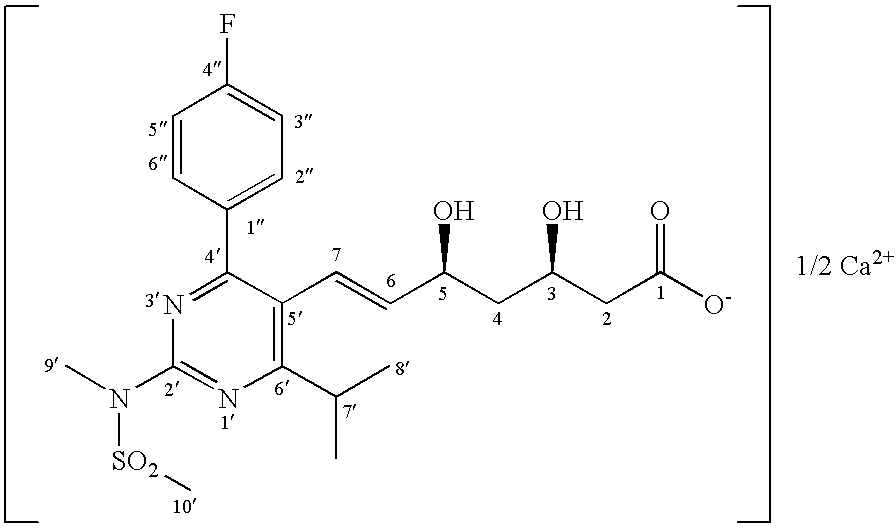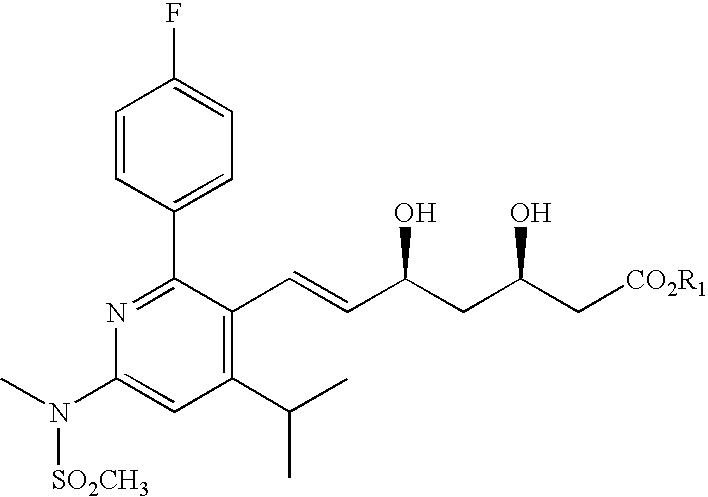Diastereomeric purification of rosuvastatin
a technology of rosuvastatin and diastereomeric impurities, which is applied in the field of intermediate rosuvastatin, can solve the problems of diastereoisomeric impurities
- Summary
- Abstract
- Description
- Claims
- Application Information
AI Technical Summary
Benefits of technology
Problems solved by technology
Method used
Image
Examples
example 1
Reverse Addition with DEMB According to U.S. Pat. No. 5,189,164
[0107] A 25 ml flask equipped with nitrogen bubbler and a magnetic stirrer was charged with TB21 (1.0 g), tetrahydrofuran (0.35 ml) and methanol (0.1 ml), forming a suspension. The suspension was stirred at room temperature to obtain a clear solution.
[0108] A 50 ml 3 necked flask equipped with a mechanical stirrer and a nitrogen bubbler was charged with tetrahydrofuran (4.4 ml) and methanol (1.2 ml), and cooled to −78° C. NaBH4 (0.192 g) was added, followed by diethylmethoxyborane (2.05 ml, 1M in THF), to form a mixture that was stirred at −78° C. for 10 minutes.
[0109] The solution of TB-21 was added to the mixture of NaBH4 and diethylmethoxyborane via a syringe over a period of about 1.5 hours, forming a reaction mixture. The reaction mixture was stirred at −78° C. for 30 minutes. H2O2 (0.8 ml, 30%) was added and the reaction mixture was allowed to reach room temperature, and was then evaporated to dryness to obtain ...
example 2
Reverse Addition with DEMB in 60 Volumes Solvent
[0111] A 50 ml flask equipped with nitrogen bubbler and a magnetic stirrer was charged with TB-21 (1.0 g), tetrahydrofuran (3.5 ml) and methanol (1.0 ml). The suspension was stirred at room temperature to obtain a clear solution.
[0112] A 50 ml 3 necked flask equipped with a mechanical stirrer and a nitrogen bubbler was charged with tetrahydrofuran (44.0 ml) and methanol (12.0 ml) to obtain a mixture. The mixture was cooled to −78° C., and NaBH4 (0.192 g) was added, followed by diethylmethoxyborane (2.05 ml, 1M in THF). The mixture was stirred at −78° C. for 10 minutes.
[0113] The TB-21 solution was added to the mixture via a syringe over 1.5 hours, forming a reaction mixture, and then the reaction mixture was stirred at −78° C. for 30 minutes. H2O2 (0.8 ml, 30%) was added and the reaction mixture was allowed to reach room temperature. The reaction mixture was evaporated to dryness to obtain a residue.
[0114] Ethyl acetate (5 ml) was ...
example 3
Reduction with DEMB, Normal Addition
[0115] A 100 ml 3-necked flask equipped with a mechanical stirrer, rubber septum and nitrogen bubbler was charged with TB-21 (1.0 g), THF (47 mL) and methanol (13.5 mL) to obtain a mixture. The mixture was stirred at room temperature until the TB-21 was dissolved. The resulting solution was then cooled to −78° C.
[0116] Diethylmethoxyborane (1M in THF, 2.80 mL) was added to the solution via a syringe and the solution was further stirred for 30 minutes at −78° C. NaBH4 (0.106 g) was added to the solution, forming a reaction mixture which was stirred for 3 hours at −78° C. H2O2 (0.8 mL, 30% in water) was added at −78° C. The reaction mixture was allowed to reach room temperature and was evaporated to dryness to obtain a residue.
[0117] Ethyl acetate (5 mL), water (5 mL) and NaCl saturated (3.5 mL) were added to the residue, and the organic phase was separated and further washed with NaHCO3 saturated (4 mL), Na2SO3 saturated (4 mL), and NaCl saturat...
PUM
| Property | Measurement | Unit |
|---|---|---|
| temperature | aaaaa | aaaaa |
| temperature | aaaaa | aaaaa |
| temperature | aaaaa | aaaaa |
Abstract
Description
Claims
Application Information
 Login to View More
Login to View More - R&D
- Intellectual Property
- Life Sciences
- Materials
- Tech Scout
- Unparalleled Data Quality
- Higher Quality Content
- 60% Fewer Hallucinations
Browse by: Latest US Patents, China's latest patents, Technical Efficacy Thesaurus, Application Domain, Technology Topic, Popular Technical Reports.
© 2025 PatSnap. All rights reserved.Legal|Privacy policy|Modern Slavery Act Transparency Statement|Sitemap|About US| Contact US: help@patsnap.com



